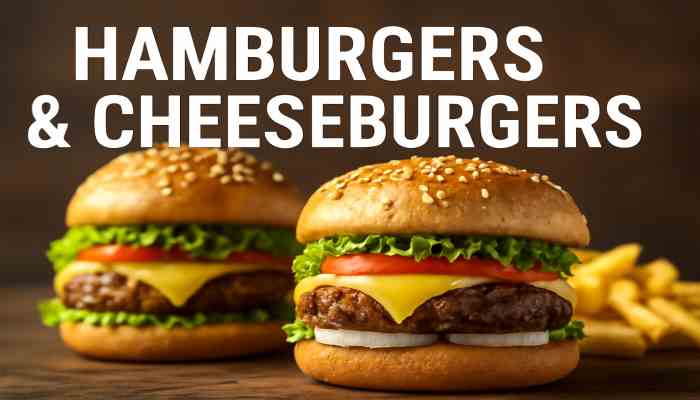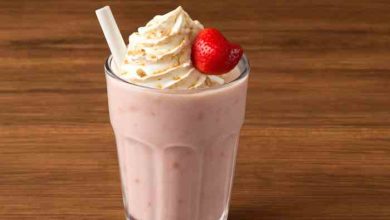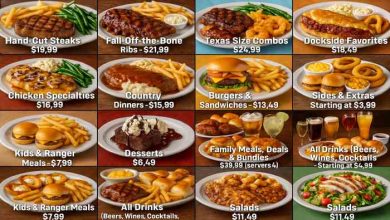Hamburgers & Cheeseburgers: The Ever-Popular Fast Food Staples

Today, as we look at the ever-changing food trends in the U.S., one thing remains clear – hamburgers and cheeseburgers are here to stay. As American as apple pie, these classic dishes are the heart of the fast food industry. Whether it’s a quick bite at a fast food restaurant or a homemade creation, the love for these meals continues to grow.
Table of Contents
The Rise of Fast Food Culture
In the early 20th century, fast food restaurants began popping up across the United States, introducing the world to the convenience of quick meals. Among the first to appear were those serving hamburgers, cheeseburgers, and later chicken sandwiches. These were simple but filling meals, perfect for the busy lifestyle that was emerging in post-war America.
It was in the 1940s that the McDonald brothers revolutionized the fast food industry. They streamlined food preparation, offering customers a quick meal for a low price. Their hamburgers, cheeseburgers, and fries became the standard. The innovation caught on, and soon, other fast food chains were offering similar menus, each with their twist on the classic burger.
Now, in 2025, the hamburger and cheeseburger are still at the top of the fast food game. They have adapted over the years, but the core of the meal has remained the same – a bun, a patty, and a side of something crispy. Some restaurants serve them with a variety of toppings, from bacon to pickles, while others add gourmet touches like fancy cheeses and sauces.
What Makes a Great Hamburger or Cheeseburger?
A fast food restaurant serves hamburgers, cheeseburgers, and chicken sandwiches in ways that appeal to nearly every taste bud. The best hamburgers and cheeseburgers start with quality beef. Many chefs recommend using fresh ground beef with a fat content of 80/20 for a juicy and flavorful patty.
Cheeseburgers, of course, are an even more popular choice, offering a perfect blend of meat and cheese. American cheese is a staple, but many chains have experimented with various types such as cheddar, Swiss, and even blue cheese. Toppings like onions, lettuce, tomatoes, and pickles are often added for a crunchy contrast, while sauces such as ketchup, mustard, or mayonnaise complete the flavor.
In recent years, the demand for plant-based options has surged. Restaurants now serve veggie burgers or plant-based patties as a meat alternative, with the Impossible Burger and Beyond Meat leading the way in taste and popularity. These innovations allow vegetarians and vegans to enjoy a hamburger or cheeseburger without compromising their dietary preferences.
The Impact of Fast Food on American Culture
It’s hard to overstate the impact that hamburgers and cheeseburgers have had on American culture. For many, the experience of eating at a fast food restaurant serves as a reminder of childhood or family outings. The golden arches of McDonald’s, the King of Burger King, and the red-and-white stripes of Wendy’s are more than just brand symbols – they are icons of American life.
Hamburgers and cheeseburgers are so intertwined with American culture that they have even been elevated to a status of pride. In 2000, the U.S. celebrated National Hamburger Day on May 28, and it has since become a tradition in many American homes. On this day, fans of the beloved meal gather together to grill hamburgers and enjoy the simple pleasure of good food and company.
Also Check: Denny’s All-American Slam Review – June 2025 Update
How the Hamburger Has Evolved Over Time
From the original McDonald’s hamburger, which consisted of just a patty, a bun, and ketchup, to today’s elaborate gourmet creations, the hamburger has changed dramatically. Many chefs now prepare burgers with unusual toppings and extravagant ingredients. These high-end burgers are often served at restaurants, where chefs experiment with unique flavors and premium meats like wagyu beef.
Despite this, the humble fast food burger remains immensely popular. As a fast food restaurant serves hamburgers, cheeseburgers, and chicken sandwiches to customers across the U.S., it’s clear that people still appreciate the simplicity of the classic burger. Whether it’s a quick meal on the go or a treat with friends, hamburgers and cheeseburgers continue to define the fast food experience.
The Global Love for Hamburgers
Though hamburgers and cheeseburgers are quintessentially American, their influence has spread far and wide. Fast food chains like McDonald’s and Burger King have opened restaurants in every corner of the globe, introducing new generations to the taste of the classic American burger. In some countries, local versions of hamburgers have been created to cater to local tastes, combining regional ingredients with the traditional hamburger patty.
For example, in Japan, the teriyaki burger is a popular choice, while in India, veggie burgers made with potatoes and spices have become a staple. This adaptability has allowed the hamburger to grow beyond its roots, becoming a global food phenomenon.
Healthier Alternatives and Customization
As consumers become more health-conscious, the demand for healthier options has risen. Many fast food chains now offer “light” or “low-calorie” options, swapping regular buns for whole wheat or gluten-free varieties. Some even serve lettuce wraps in place of buns for those watching their carb intake.
Additionally, customers today have more control over their meals than ever before. Many fast food chains offer the ability to customize burgers to their liking, choosing everything from the type of cheese to the types of sauces and toppings. This customization ensures that each burger is tailored to the individual’s tastes, making the meal even more enjoyable.
FAQ: Hamburgers & Cheeseburgers
1. What is the difference between a hamburger and a cheeseburger?
A hamburger is simply a beef patty served in a bun, while a cheeseburger includes a slice of cheese, usually melted, on top of the patty. The addition of cheese adds extra flavor and creaminess to the burger.
2. Are there any plant-based alternatives to hamburgers and cheeseburgers?
Yes! Many fast food restaurants now offer plant-based patties like the Impossible Burger and Beyond Meat as alternatives to beef. These vegan-friendly burgers provide the same taste and texture as traditional beef burgers.
3. Can I customize my hamburger or cheeseburger at a fast food restaurant?
Yes, most fast food restaurants allow you to customize your burger by adding or removing ingredients. You can choose different types of cheese, sauces, vegetables, and even the type of bun.




